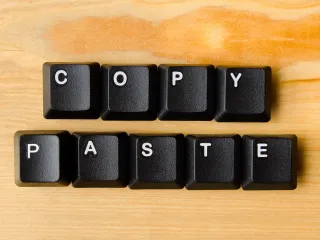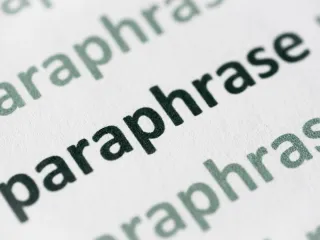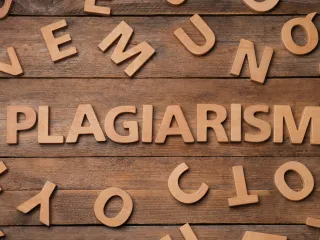How to Cite a Movie: MLA, APA, and Chicago Style
Writing a research paper doesn’t mean limiting your sources to books and articles. You might use a movie, and if you do, you need to know how to cite it properly. Since there are different citation guides, you must follow the directions specific to your paper style.
The most popular formats are MLA style, APA format, and Chicago style. Each style guide has unique, yet very specific guidelines for spacing, punctuation, italics, and more.
Creating a movie citation for a motion picture you’re referencing protects you against plagiarism. When you’re using other people’s ideas or words, you have to credit them in your work. Otherwise, it looks like you’re passing the information off as your own. If you write anything that isn’t an original idea, you need to credit the person who said it first or you are plagiarizing.
Referencing a movie in your paper can take many different forms. You might mention the film in passing. You might compare it to other films or works of literature. You could also dedicate a whole paper to discussing one specific movie and its impact on popular culture.
You can quote lines from films in your paper just as you’d quote a researcher. Put the sentence in quotation marks and include an in-text citation. You’ll find out how to do that when you learn how to cite a movie in MLA, APA, and Chicago Style.
Common Movie Citation Formats
To cite a motion picture, you’ll need some basic information. Having these details on hand will help whether you’re using MLA, APA, or Chicago style for the film citation. All citation guides require information like:
- Title of the movie
- Name of the director
- Production company
- Film distributor
- Year of release
There are certain instances to use each format, so below are citation examples for MLA style, APA style, and Chicago style.
MLA Style
The Modern Language Association created MLA style. The handbook has undergone many changes over the years and is now in its ninth edition. It’s updated as technology and research change. The original handbook had information about citing books and papers, yet the modern edition tells you how to cite song lyrics, social media posts, and more.
You’re likely to use MLA style when writing papers for the humanities, such as language arts or cultural studies. Writing a film critique or using movies to comment on society falls under the humanities umbrella, and you are likely to use MLA style for such projects.
MLA Style Movie Citations
Citing a movie in MLA style is very similar to citing other sources. Start with the movie title in italics, then identify the director or directors. You can list a few stars if you mention them in your paper. This level of detail helps readers find the exact citation in your MLA Works Cited page.
Most of the punctuation in a movie citation using MLA format is a comma. This punctuation differs from other MLA citations that use a lot of periods or put information in parenthesis. Here is an example of a movie formatted for an MLA citation:
Movie. Directed by Bob Action, performances by Ima Star, Big Name, and Too Famous, Movie Studios, 2020.
It’s a straightforward process with room to specify what version you’re referencing if there are multiple versions of the film. In that case, you would add the version after the director’s name. For example:
Movie. Directed by Bob Action, extended version, Movie Studios, 2020.
If you watched the movie on a streaming service, you should indicate that information. Just as when you’re citing journal articles found online with a URL or DOI, the streaming service helps the reader find the exact film.
Most streaming services upload the regular version of the movie, but including this detail erases all doubt. Netflix and other streaming services change up their inventory periodically, so cover your bases by including the date you watched the movie. Otherwise, a reader might think you’re making up information because the film isn’t currently available through the service.
Maybe the service censored the line you quoted, and people who own the DVD know the real language. They might think you got the information wrong in your paper. When they go to your reference page, they’ll see where you accessed the movie and understand how your experience could differ. Here is an example of a movie formatted for an MLA citation if it was on a streaming service:
Movie. Directed by Bob Action, Movie Studios, 2020. Netflix, 13 May 2021.
You can also cite movies you watched on YouTube. The format is similar to that of a streaming service, except you include the name of the user who uploaded the film and the specific URL. For example:
Movie. Directed by Bob Action, Movie Studios, 2020. Movie. Directed by Bob Action, performances by Ima Star, Big Name, and Too Famous, Movie Studios, 2020. YouTube, uploaded by Film Appreciation Community, 13 May 2021, http://www.youtube.com/specificvideo.
When you compile your works cited list, you’ll put the movie citation in alphabetical order according to the movie title.
MLA Style In-text Citations
You need to include an in-text citation whenever you mention the film in your paper. If you paraphrase anything from the movie, you need to show the reader what you’re referencing. Text citations are easy to figure out once you have the reference completed for your works cited page.
Use parentheses to signal that you’re citing a source in the body of your paper. After the opening parenthesis, put the movie title in italics. For example:
(Movie)
However, there are other times when you’ll need in-text citations. If you use a direct quote from the movie, close the quotation marks of the passage, and include the text citation before the ending punctuation. This citation will include the title of the movie and the timestamp of when the character speaks the specific line. You still put the movie title in italics inside of the parenthesis. Follow the title with the timestamp and duration of the line using a semicolon to show the time. For example:
(Movie 15:10-35)
If the quote goes beyond one minute, clarify the time range with more details, such as:
(Movie 15:10-16:07)
You can also mention the movie title in your text using general context without needing an in-text citation. For example:
In Movie, the viewer goes on a wild adventure that spans just two hours.
If you mention a specific part of the movie, you’ll need to add an in-text citation with the time stamp. For example:
In Movie, the viewer first visits the graveyard at night (1:03-50).
If the movie title is long, you can shorten it to the first few words, so your in-text citations are concise.
APA Style
The American Psychological Association created the APA style guide. It has detailed parameters for academic and research papers. You use the APA format when working in the social sciences, like psychology, sociology, economics, and related fields.
APA Style Movie Citations
While a movie citation in MLA style is very basic, there is more specific formatting for an APA citation. Instead of starting with the movie title, you list the director starting with the last name, then the first initial. Specify that the person is the director in parentheses. Documentaries would have a producer instead of a director, so you’d use that job title instead.
Next, you put the year the company produced the movie, then the title. In square brackets, specify that it’s a film because TV shows use a similar style, and last is the name of the production company. Here is an example of a movie formatted for an APA citation:
Action, B. (Director). (2020). Movie [Film]. Movie Studios.
You might refer to the special features included on a DVD version of the film, so you’ll add this information to your citation. For example:
Action, B. (Director). (2020). Movie [Film; DVD release]. Movie Studios.
If you watched the film on a streaming service, the citation includes those details as well. For example:
Action, B. (Director). (2020). Movie [Video file]. Retrieved from http://www.netflix.com
When you compile your reference list, you’ll put the movie citation in alphabetical order according to the director’s last name.
APA Style In-text Citations
In-text citations for APA format are similar to those of MLA style. As always, you use parentheses to offset the information from the body of your paper and the citation goes inside of the ending punctuation of a sentence.
While MLA uses the movie title, APA calls for the director’s last name and the year of the movie. For example:
(Action, 2020)
If you’re quoting the film or mentioning a specific scene, include the timestamp after the director’s name and year. For example:
(Action, 2020, 0:15:10)
Chicago Style
The University of Chicago created Chicago Style for use in the humanities, sciences, and social sciences. This format differs from both MLA and APA by having a bibliography instead of works cited or reference pages. Some papers using Chicago Style ask for you to create endnotes as well.
Chicago Style Movie Citations
Chicago Style has two options: author-date or notes-bibliography. Your professor will tell you what to use for a student paper. If you’re writing an article to submit to a journal, the submission guidelines will clarify which format you need to use.
The author-date format is similar to APA citations. You start with the director’s last name, then their first name, then the job title of the director. This detail is to clarify the person’s role in the movie because a documentary would have a producer instead of a director.
Next is the year the production company released the movie, followed by the movie’s title in italics. Check out this citation example to see how similar it is to APA format:
Action, Bob, director. 2020. Movie. Movie Studios.
If you watched the movie online, you would add the streaming service and direct URL to the movie. Here is an example:
Action, Bob, director. 2020. Movie. Netflix. http://www.netflix.com/movieaddress
If you’re using the notes-bibliography style instead of author-date, you need all the same information but the order is different. Here is an example:
Action, Bob, director. Movie. Movie Studios, 2020.
If you watched the movie online through a streaming service, you add that information in slightly different places as well. For example:
Action, Bob, director. Movie. Netflix, 2020. http://www.netflix.com/movieaddress
Chicago Style In-text Citations
The author-date in-text citation format is also similar to APA’s text citation, without a comma. In Chicago Style, an author-date in-text citation example is:
(Action 2020)
If you’re referencing a specific quote or scene, you’d include the timestamp of the duration. Instead of using a dash like in MLA format, you write the word “to.” Here is an example:
(Action 2020 0:15:10 to 0:15:35)
The in-text citations for author-date style are the same whether you watched the movie on DVD or on Netflix. The reader can find that information when they look for the citation in your bibliography.
When you’re using the notes-bibliography style, in-text citations are understandably different. You number the note and include all the information from the bibliography citation for the first note. Later, you can use a shortened note to reference each movie version because you’ve already given the entire information in the first note.
Considerations for Citing Movies
Citing a movie isn’t too different from citing a book across various style guides, but you must pay attention to the details. Streaming services like Netflix and Hulu changed the TV industry. It’s very simple to access movies and TV series you might not find otherwise.
When you watch movies online, make sure to cite if it came from Netflix or if it’s a YouTube video. While this article focused on movie citations, there are also differences when citing a TV show or podcast.
Easy Ways to Cite a Movie
Once you learn the basic information needed for a citation, it’s relatively simple to follow the specific formats for MLA, APA, or Chicago Style.
Doing large amounts of research can make it hard to focus on your references. Using the Quetext citation generator simplifies the process for you. Whether you’re working on an academic paper, a professional article, or checking your students’ work, Quetext helps with the citations while also checking for any sign of plagiarism.
Take out the stress and confusion of punctuation and parentheses, and let Quetext do the work for you.









